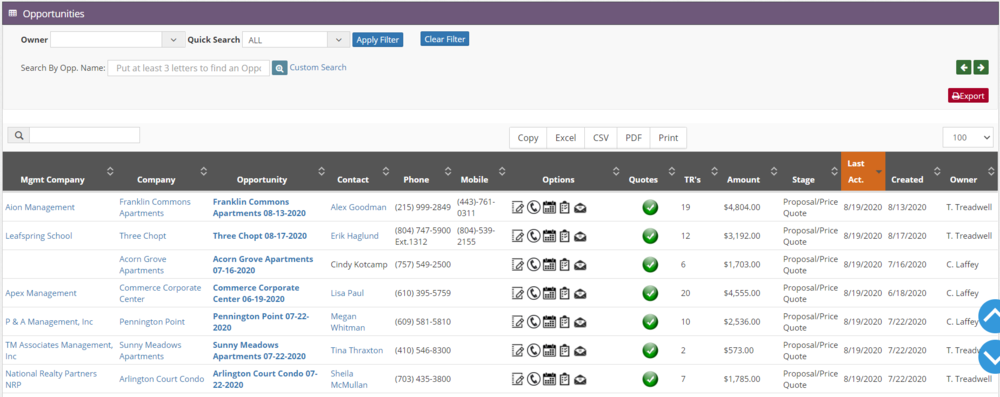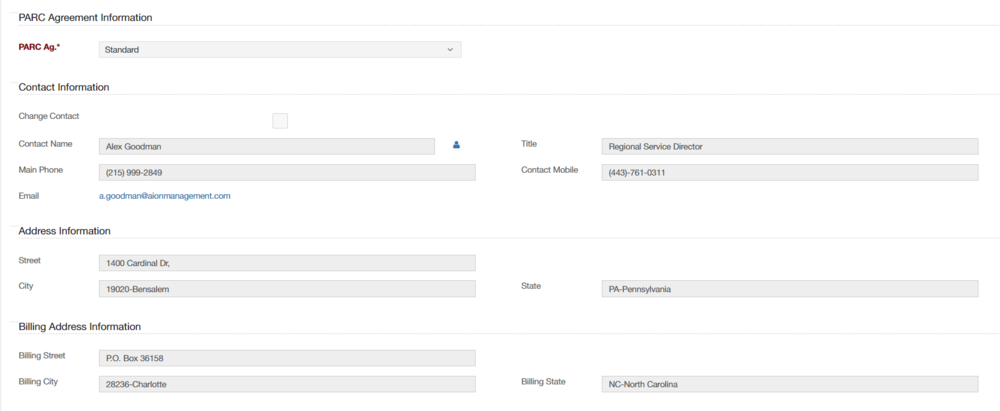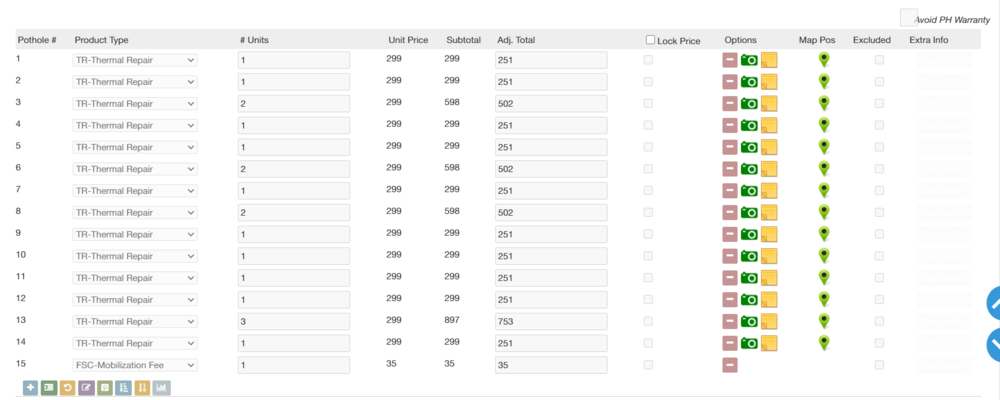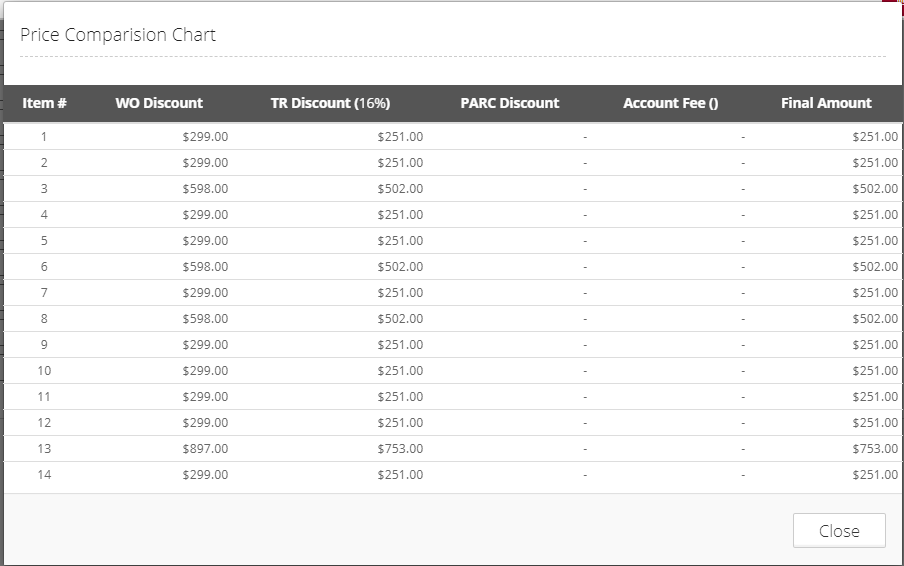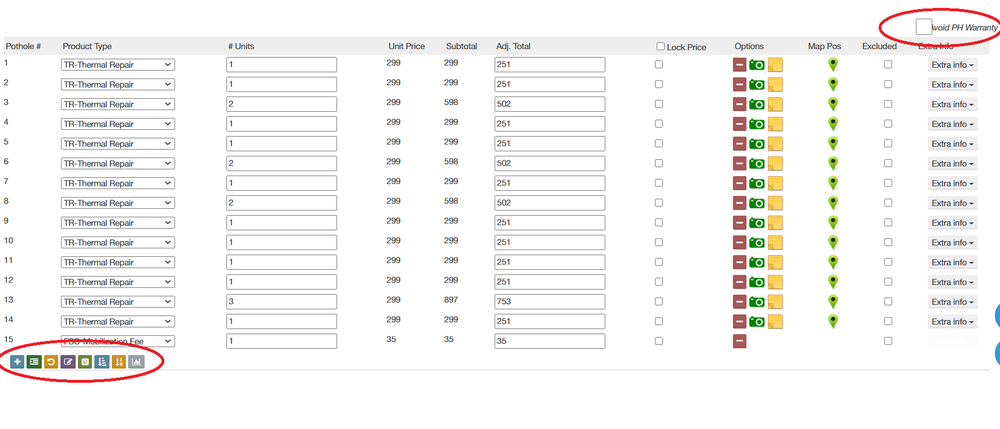Difference between revisions of "Opportunity"
| Line 213: | Line 213: | ||
[[File:656.png|1000px|thumb|center]] | [[File:656.png|1000px|thumb|center]] | ||
| + | |||
| + | ==Quotes== | ||
| + | |||
| + | This section shows all the information regarding the work that needs to be done and its price. | ||
| + | |||
| + | Users can access information like the amount of potholes to fix, the estimated units of thermal repairs for each PH, price, pictures and notes and PH location. | ||
| + | |||
| + | |||
| + | [[File:657.png|1000px|thumb|center]] | ||
| + | |||
| + | |||
| + | ===Information in this tab=== | ||
| + | |||
| + | * Pothole number | ||
| + | * Product type: whether it is a thermal repair or a remedial repair, for example. | ||
| + | * Units: estimated quantity of the product type needed | ||
| + | * Unit price: | ||
| + | * Subtotal | ||
| + | * Adj total | ||
| + | * Lock price: this option locks the quoted price | ||
| + | * Options: these actions allow the user to delete the item, upload pictures and add notes. When the camera icon is shown in red this means that no pictures have been uploaded for that PH. Once the pictures have been uploaded it will turn green. | ||
| + | * Map position: informs whether the coordinates have been validated. A red mark means coordinates have not been validated by the user. Once done, the red mark will turn green. | ||
| + | * Excluded: excludes the item from the quote | ||
| + | * Extra info: extra information about the pothole | ||
| + | * Special instructions: free text field. Special Instructions for dispatch based on site survey - enter notes here | ||
| + | |||
| + | At the end of the list the system also provides the user with a quote summary. | ||
| + | |||
| + | |||
| + | [[File:658.png|1000px|thumb|center]] | ||
| + | |||
| + | |||
| + | ===Available actions in this tab=== | ||
| + | |||
| + | User can edit the information presented in this tab and perform the following actions: | ||
| + | |||
| + | * Add Pothole | ||
| + | * Quotes bulk load: allows the user to quickly add a big amount of potholes | ||
| + | * Reset grid: erases all items | ||
| + | * Re-assign images | ||
| + | * Add PARC item | ||
| + | * Reorder items: sorts potholes by number | ||
| + | * Reorder items: resets pothole number | ||
| + | * View price comparison chart: pops up a graph with price information. See picture below. | ||
| + | |||
| + | |||
| + | [[File:661.png|1000px|thumb|center]] | ||
| + | |||
| + | |||
| + | This set of actions can be found on the bottom left corner, right under the last quoted pothole users can select the option for avoiding PH warranty. This can be done by ticking the checkbox at the top right corner of the tab. | ||
| + | |||
| + | |||
| + | [[File:662.png|1000px|thumb|center]] | ||
Revision as of 18:27, 21 October 2020
An Introduction
Let us remember that opportunities are generated once the Lead has been created and accepted to get a proposal from Porthole Repair. And it is required to have at least one opened RPH created, for the lead or account before proceeding with the Opportunity creation.
As all sales professionals understand, a small number of prospects and clients will be motivated enough to follow up with the company and sign the contract in a timely fashion. It is our job to make life easier for our clients, so we do not just send quotes to file and forget about them. Potholes do not fix themselves; they just grow larger and become more expensive to repair. Our clients are very busy and manage multiple projects at many properties, so we stay on top of our opportunities and help them avoid bigger problems.
This module has the tools to provide consistent and professional follow up as necessary to produce consistent sales revenue.
A definition
An opportunity is a specifically defined number and scope of repairs that the client can either authorized or not.
There is no significant difference between a quote and an opportunity.
Opportunities are always nested under either a Lead or an Account. It is possible to have more than one opportunity under Lead if none of the opportunities ever result in a sale. Otherwise as soon there is a sale, the Lead is converted to an Account.
Further no Lead or Account can have 2 opportunities opened at the same time, because what an opportunity is by definition is a recommendations for one or more repairs.
How is it generated?
There are a number of ways an opportunity can be generated.
Let’s start with the less frequent option, which is via an automated PARC process. Remember a PARC agreement is doing 3 inspections a year, and in order to do an inspection we need to have an opportunity. These opportunities are automatically created within the system once a customer signs a PARC Agreement.
Another way that an opportunity can be created (this option kind of crosses a couple of lines) is when eventually a quote may be approved. And if it is approved, all of these repairs will be under warranty. Once the work is done and the job invoiced, maybe we did a great job but one or two repairs failed and either we discover it or the client calls. What we do in this situation is a remedial repair, which by definition is warranty repair. In order to have a warranty repair you first have to have a repair that the client bought and paid for. So we need to go back to the original opportunity and create a new remedial repair and re-open the opportunity excluding those portholes that don’t need any fixing.
A more normal path for creating an opportunity is as a result of the marketing campaign efforts, in other words when the sales process is successful, and the client accepts our proposal.
At this stage an RPH must be created, if it hasn’t been already created. This is a requirement of the system, no opportunity can be created unless there was an open RPH linked to the Lead or Account that opportunity is going to be created for.
Opportunity types
What we explained before are the ways or circumstances in which most opportunities can be created. Now we’ll see the types of opportunities we can create and the purpose of this classification.
New Business Opportunity: only applies for those situations when it is the first time we have ever done any job on the site (the contact or the account could be a client that has already worked with us, but it is the first time working on the site.
Repeat Business Opportunity: on the contrary, we consider a repeat business when we have done some work before at a specific address.
Remedial Repair Opportunity: a warranty repair. When a job fails we provide a remedial repair to fix it.
Demo Repair Opportunity: this is a very unique type of opportunity. One of the tools we use when we find a new management company and we want to make business with them, we will arrange to have a meeting with their executives at a specific time and time to do a repair for free. The only restraint to them is to attend and watch. It is very for us to make sure the customer goes through to whole customer journey, so we will generate the initial proposal at a zero dollar cost, the scheduling process and emails through the dispatch office, when the technicians arrive and open the app a notification is sent, and when the job is completed the documentation and the invoice are sent. It follows the whole process so the customer get to “feel” the full experience of doing business with us, except for the fact that this time only they will be getting it for free.
Flexible Opportunity: sometimes for various reasons a customer will hire us but neither they or us know specifically what potholes are on their lot, how many or how big these are. So in this case they will sign an NTE (Not To Exceed) authorization. This means that our company is allowed to fix their potholes up to a certain limit of money which is fixed by the customer. So when technicians arrive at the site they will fix all the potholes they can without going over that limit.
CWP Opportunities: this type of opportunities applies for all jobs done under the Cold Weather Programme. Working with hot asphalt in cold weather can be very challenging. The way CWP works is: once it is below 41ºF we know we don’t do well at repairs, we can do them but they take really long time and they fail a lot. So we have a system control called “winter mode” that allows us to come back during the spring to finish the work and do a permanent installation.
Opportunity Menu
View all opportunities
Very similar to other modules, here is possible to see the list of the existing Opportunities in the database, filtered by specific parameters. There is also a search bar that can be used to refine the search by looking among the shown results.
Filters available are:
- Owner: filter by the owner of the Account
- Quick Search: filter by predefined range of time
- Search by Opportunity name
It is also possible to activate the “Custom Search” that will enable more fields of filtering, such as:
- From date (creation)
- To date (creation)
- Stage
Once the filtering is done, the system will show the results in a list. The user can search among the results by writing on the “Search” field (magnifying glass); the system will refine the results if there are matches with any field of the shown results.
The results can be extracted and downloaded to the local disk in different formats such as CSV, Excel, PDF or can be directly printed or copied to the clipboard.
Information shown in this columns:
- Management Company: is the Parent account of the shown account.
- Company
- Opportunity
- Contact: is the main contact of the account.
- Phone
- Mobile
- Quotes: indicates whether there are quotes for the account. If yes, a green check mark will be shown.
- TR’s: amount of thermal repairs
- Amount
- Stage
- Last activity
- Created: date of opportunity creation
- Owner: owner of the account. Who protects the account at the moment.
From this list there is also access to the column “Options”, with more buttons that work as shortcuts to:
- Log a new call
- Create a new event
- Create a new tasks
- Send a new email.
- Add new note
View external proposals
Here is possible to see the list of the existing External Proposals in the database.
The only available filters are:
- From date (creation)
- To date (creation)
- Status
Yet, there is a search bar that can be used to refine the search by looking among the shown results.
Once the filtering is done, the system will show the results in a list. The user can search among the results by writing on the “Search bar” (magnifying glass) and it will refine the results if there are matches with any field.
The results can be extracted and downloaded to the local disk in different formats such as CSV, Excel, PDF or can be directly printed or copied to the clipboard.
Information shown in this columns:
- Proposal ID: ID number
- Company: the customer Pothole Repair is working for
- Contact
- Phone
- Mobile
- Location
- County
- ZIP code
- Partner: partner company working with Pothole Repair
- Status
- Amount
- Last activity
- Created: date of opportunity creation
- Owner: owner of the account. Who protects the account at the moment.
How to create an opportunity
There are several ways to create an Opportunity, nevertheless most often we use two ways.
The first one, from the Lead or Account page, by clicking on the button “Create Opportunity”
This triggers a validation within the system to check there is an opened RPH for the Lead/ Account.
If there is not an RPH created for the Lead/ Account, then the system will ask the user to proceed to open a new one. In which case the user needs to fill the RPH creation form, explained in previous sections of this wiki.
If the RPH already exists, then the user will be redirected to the Opportunity creation form.
The other one is from the Reported PH’s tab in the Account/ Lead module, by clicking on the money symbol. This can be done when the RPH has been previously created, otherwise there would not be any available records valid for creation.
Note that when creating an opportunity, the system performs two validation processes regardless of the way of creation.
First the system validates there is an RPH whose status is open, this generates a double relationship between the RPH that exists and the opportunity to be created.
On the other hand, the system also verifies that the user who is creating this new opportunity is also the owner of said account. If not, then the system will give the user the option to create with or without splitting the opportunity.
Information contained within the opportunity
The account information can be found in tabs that contain different types of information, and which is unique for such Account.
These Tabs are:
- Opportunity info
- Quotes
- Images
- Documents
- Related RPH
- Events and activities
- External proposal
- History
- Quote history
- Work history
Opportunity info
This tab contains general information about the opportunity and the account linked to it. This information is sorted within the following subsections
Opportunity information: This is the same information shown in the Opportunity Menu section for “View all opportunities”, such as proposal number, stage, owner, account, etc. And all this information is auto-populated from the other modules. When the opportunity is generated the information (or at least most of it) is auto-populated from the Lead or Account linked to the opportunity.
The system sets by default a name for the opportunity, which is formed by the name of the account and the date of creation for the opportunity. It also sets the stage Proposal/ Price Quote and a probability of 35%, which is assigned by default as well.
PARC agreement for the account: users can edit the information in here by selecting the type of PARC (Standart, PARC 1, PARC 2 and Final)
Contact: The information for this part is auto-populated, nevertheless users have the option to edit the main contact and choose a new one. In order to do it they need to tick the checkbox and then select the desire contact
Address: this information can’t be edited from this module and is also auto-populated
Billing address: once again, this information can’t be edited from this module and is auto-populated.
Opportunity description: free text box to add any information about the opportunity
Lock opportunity: check-box to lock the opportunity
Quotes
This section shows all the information regarding the work that needs to be done and its price.
Users can access information like the amount of potholes to fix, the estimated units of thermal repairs for each PH, price, pictures and notes and PH location.
Information in this tab
- Pothole number
- Product type: whether it is a thermal repair or a remedial repair, for example.
- Units: estimated quantity of the product type needed
- Unit price:
- Subtotal
- Adj total
- Lock price: this option locks the quoted price
- Options: these actions allow the user to delete the item, upload pictures and add notes. When the camera icon is shown in red this means that no pictures have been uploaded for that PH. Once the pictures have been uploaded it will turn green.
- Map position: informs whether the coordinates have been validated. A red mark means coordinates have not been validated by the user. Once done, the red mark will turn green.
- Excluded: excludes the item from the quote
- Extra info: extra information about the pothole
- Special instructions: free text field. Special Instructions for dispatch based on site survey - enter notes here
At the end of the list the system also provides the user with a quote summary.
Available actions in this tab
User can edit the information presented in this tab and perform the following actions:
- Add Pothole
- Quotes bulk load: allows the user to quickly add a big amount of potholes
- Reset grid: erases all items
- Re-assign images
- Add PARC item
- Reorder items: sorts potholes by number
- Reorder items: resets pothole number
- View price comparison chart: pops up a graph with price information. See picture below.
This set of actions can be found on the bottom left corner, right under the last quoted pothole users can select the option for avoiding PH warranty. This can be done by ticking the checkbox at the top right corner of the tab.
